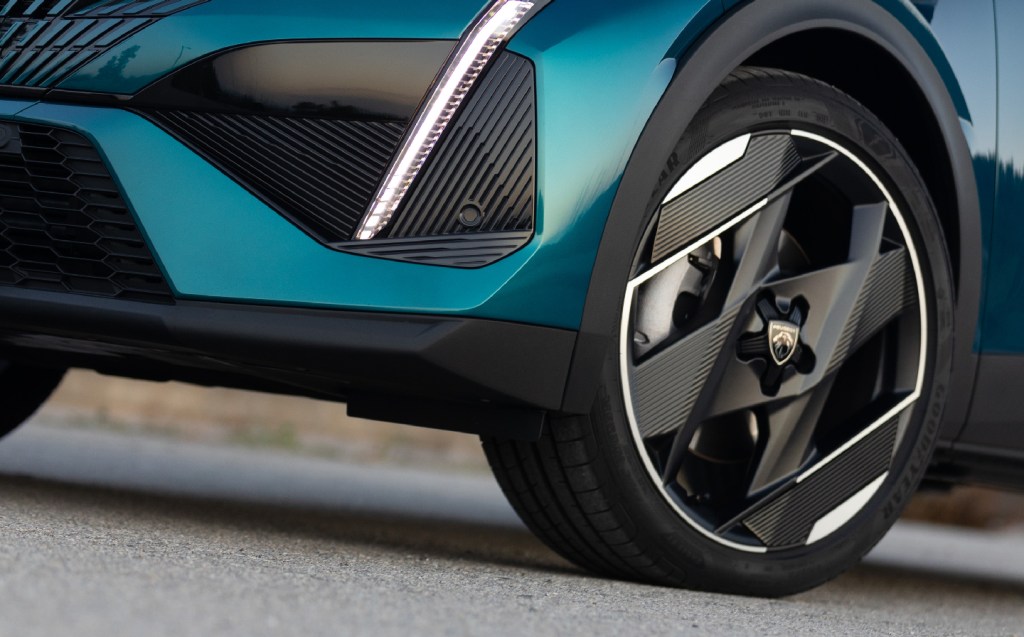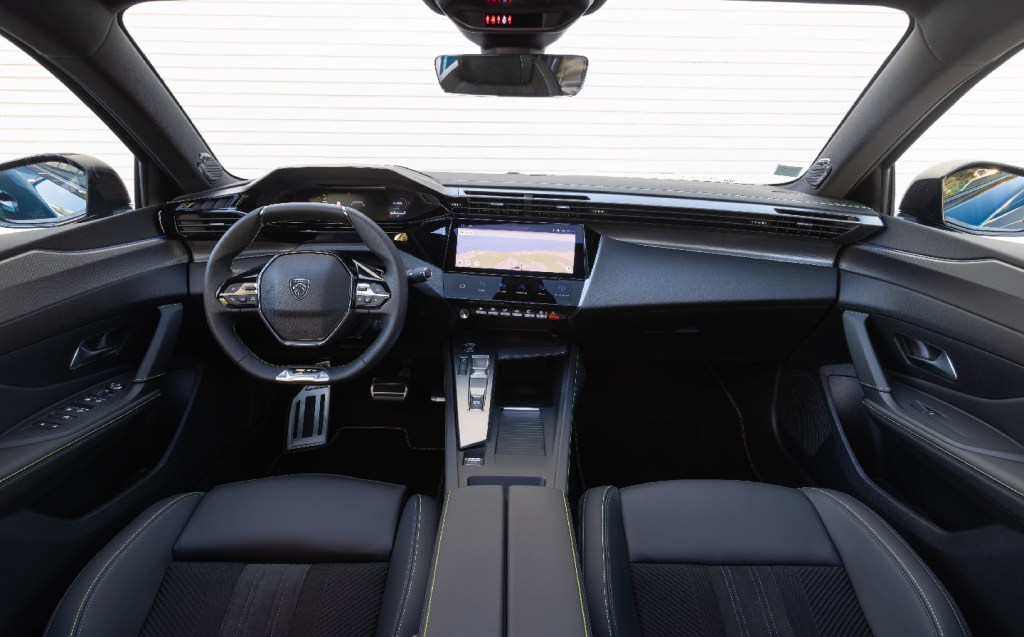Peugeot 408 PHEV 2023 review: Is the plug-in coupé-crossover everything to everyone?
Allure? Allure?
The genre-splicing new Peugeot 408 is for car buyers who “are looking for uniqueness, appreciate creativity and the audacity of new combinations that break away from established categories,” according to the press bumf. It’s true that its shape is odd, though the 408 shares the same underpinnings as the equally weird Citroën C5 X and there are plenty of jacked-up coupé-style cars cropping up — just look at the Renault Mégane E-Tech or Kia EV6.
Suggesting that the coolest, most progressive customers demand vehicles that defy convention is designed to flatter their egos, of course, but the truth of the matter is that carmakers are jacking up saloons and coupés so that drivers who now only seem to want SUVs might be tempted.
The other reason even non-SUVs are getting taller is that their underpinnings are now designed to take electric powertrains, even if petrol and hybrid variants are offered alongside, which means a thicker floor to accommodate the battery, which in turn raises the overall height.
The new 408 is just such a car. The version we tested on the launch in Spain was a plug-in hybrid (one of two versions), though a petrol model is also available and a pure-electric version is to follow.
But is it any good? And does it, as Peugeot was so keen to tell us on the launch, have “allure”. Read on.
Design and rivals

There’s nothing wrong with the concept of a “fastback” (coupé) on stilts though the 408 is slightly odd-looking. Beauty is in the eye of the beholder, of course, and plenty of motoring journalists have stopped commenting on car design altogether for exactly that reason, but our job should be to tell you what we really think, so here you are: the nose is too fussy to my eyes, and the proportions around the rear haunches I find off-putting.
Peugeot says the 408 has a feline-like stance, which I can see if I squint, but there’s something about the rear wings that I believe doesn’t seem to work.
Other opinions are available — the writer I shared a car with really liked the look of it, she said — and there are bits that really are successful: the signature fang-like front daytime running lights and three-claw rear cluster, for example, while the cat ear projections above the rear window are a nice touch. From directly behind it’s a pretty-looking thing, actually, plastic bumper aside.
The geometric-design 20in alloys (optional on GT Hybrid versions), which create a mesmerising pattern at low speeds, are very cool, too.

Overall, though, it’s a much less successful design than the likes of the 508, which is one of the prettiest saloons available, and in SW form arguably the most handsome estate on our roads. It’s also not as handsome as the recent 308 hatchback, with which the 408 shares underpinnings (along with the new Vauxhall Astra).
If you’re fairly interested in the shape but like me are not convinced by the styling, you could also look at rivals such as the Citroen C5X mentioned above, with which the 408 will share powertrains, and the Renault Arkana. In the premium category there’s the BMW X4, and when the electric 408 arrives the Kia EV6 is one of best alternatives out there.
Interior and practicality

The inside of the Peugeot 408 is likely to divide opinion, too. Peugeot’s iCockpit layout, with a downsized steering wheel that must be positioned low enough to see the driver’s instrument binnacle above, isn’t to everyone’s tastes.
On the 408 launch, Peugeot’s product chief claimed that iCockpit has “an iconic design” that over 10 years has had “nine million satisfied customers”. Comment online and anecdotal evidence suggests some people get on with it better than others, though, and from my own experience it works better in some Peugeot models than others.
As a tall man, I found the 408’s driving position less than ideal; with the steering wheel positioned low enough for a clear view of the instruments, the bottom of the rim sat between my legs. And with my knees pushed far apart I found the 408 has the same issue as the 208, whereby the centre console is shaped to be a torture device for your inside leg — after a short time a jutting lump in the plastic was causing an ache. The seat, too, wasn’t designed to support my long spine.

Worse still is space in the rear. Peugeot is proud of the amount of space freed up for legs but headroom is a disaster, with most adults likely to feel cramped and anyone much over six foot tall in danger of having to tilt their head. At 6ft 5in, I looked ridiculous back there — there’s no other word for it.
Having said that, there was a lot that I liked. Peugeot’s 3D digital driver’s display (GT trim) remains very cool indeed (though one of the view options is ridiculously cluttered), and the 10in touchscreen is probably the best interpretation of the Stellantis infotainment out there — particularly the digital piano keys below the screen, which can be customised with shortcuts to your favourite menu screens.
And while the passenger side dashboard is an odd design, the overall fit and finish in the 408’s cabin is impressive. Certainly up there with premium alternatives in the family car segment.

In terms of boot space, there’s a decent 471 litres to fill in the plug-in hybrid model, increasing to 536 litres for the petrol model due to the fact that there’s extra space under the boot floor, where the PHEV’s battery is stored.
Ride and handling
That small steering wheel, combined with a fairly “fast” rack, translates to more significant changes of direction than one might expect from your inputs. It’s a bit odd if you’re not used to Peugeots but you quickly become accustomed to the high responsiveness, and the “direct” feel gives the 408 a sporty edge compared with some of the competition.
And once dialled into the steering feel, the car moves from corner to corner with a pleasing balance, strong grip all round, and just enough body roll to allow the suppleness needed to shrug off mid-corner bumps without feeling too soft — perhaps thanks to the 20in alloys fitted to our test car.
There isn’t the handling aplomb and definition of a BMW equivalent, and we don’t expect the electric 408 to be as impressive as a Kia EV6 through the twisty stuff, though that’s more a reflection of how good the Kia is than anything else.
That focus on suspension set-up for a wide variety of conditions also means comfort of ride without being really soft, and we didn’t find the car jarring over potholes and broken roads. There’s good sound insulation and decent refinement, too.

Performance, acceleration and electric range
The 408 Plug-in Hybrid comes in two versions: the 225 e-EAT8 combines a 178bhp PureTech petrol engine with a 109bhp electric motor, while the 180 e-EAT8 uses the same electric motor but with the petrol engine turned down to produce 148bhp.
Both feed power through an eight-speed automatic gearbox, and though they come with paddles behind the wheel, gearchanges are overridden by the electronics in short order so it’s best to just leave them alone and let the car work the cogs itself. For the most part it does a decent job, though enthusiastic driving causes a little confusion for the 408’s electronic brain as it downshifts under hard acceleration then attempts to go back up the ratios as soon as it can.
We drove the more powerful version, which has a combined 222bhp and 266 lb ft of torque, allowing a 0-62mph sprint in 7.8 seconds. That’s plenty punchy enough for an executive car, and the electric motor helps with low speed performance and torque fill.
The main point of the PHEV system, though, is efficiency, and when the 12.4kWh battery is full you’ve got up to 41.6 miles of charge on a mix of roads, officially. That means most commutes and local journeys can be completed on electric power alone, provided the battery is topped up. Expect fuel consumption overall to never reach the stratospheric quoted figures of 211.3-269.5mpg, which seem to be more plucked from thin air than based on the official tests, but if plugging in as much as possible, your trips to the petrol station should be fairly infrequent. If you don’t bother charging up at all, the extra 300kg of battery you’re lugging around over the pure-petrol model will result in much worse fuel economy.
Recharging takes between 1hr 55min, from a 7kW wallbox with the upgraded on-board charger, to 7.5 hours using a standard 3-pin UK socket (check its suitability for the job with a qualified electrician first).
Pricing and specification

Prices for the Peugeot 408 plug-in hybrid start at £38,400. That’s for the 180 e-EAT8 version in Allure trim, which comes with the likes of 17in alloy wheels, LED automatic headlights, a reversing camera and rear parking sensors, along with connected sat nav with over-the-air updates.
The more powerful 225 e-EAT8 is available from Allure Premium, and starts at £40,725 (a premium of £1,400 over the equivalent 180 e-EAT8). Specification rises through GT (£41,800 and £43,200 respectively) to the First Edition versions (which we would expect will be replaced by another range-topper in future), for £45,000.
It’s worth also bearing in mind one of the big draws for business users: an 8% Benefit in Kind (BIK) rate in 2022/23, which compares with 32% for the petrol version.
Verdict: Peugeot 408 Hybrid review
Like all plug-in hybrids, the 408 PHEV will only make sense to a very specific sort of driver – one who makes regular short trips with the ability to plug in at home and/or work. And company car drivers will see the appeal of the low BIK rates. For most, the forthcoming electric model will be the best option, though Peugeot is covering all bases by providing pure petrol power, too.
While the styling isn’t to our tastes, plenty of people we’ve spoken with think it’s a good-looking car, and the quality of the interior is impressive. It’s a shame that tall people will find neither the driving position nor headroom in the rear acceptable, but performance, handling, refinement and ride quality are all aspects of the 408 Hybrid that drivers will appreciate.
Related articles
- After reading this review of the 2023 Peugeot 408 PHEV, you might want to read our Alfa Romeo Tonale PHEV Q4 2023 review
- Also check out our review of the pure-electric Kia EV6
- Peugeot reveals retro lion logo as all new cars to be electrified by 2025
Latest articles
- Watch new Porsche 911 GT3 smash Nürburgring record for manual cars
- Skoda Elroq 2025 review: Czech carmaker can’t seem to miss with its electric family cars
- Five best electric cars to buy in 2025
- Should I buy a diesel car in 2025?
- F1 2025 calendar and race reports: The new Formula One season as it happens
- Zeekr 7X AWD 2025 review: A fast, spacious and high tech premium SUV — but someone call the chassis chief
- Denza Z9GT 2025 review: Flawed but sleek 1,062bhp shooting brake from BYD’s luxury arm
- Extended test: 2024 Renault Scenic E-Tech review
- Best-selling cars 2025: The UK’s ten most popular models of the year so far























